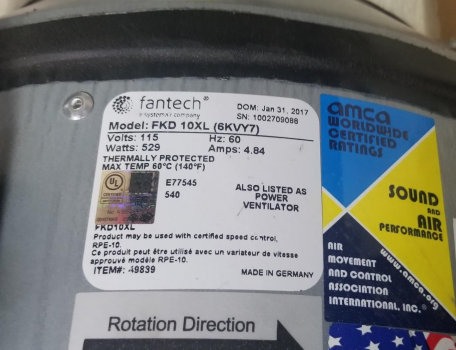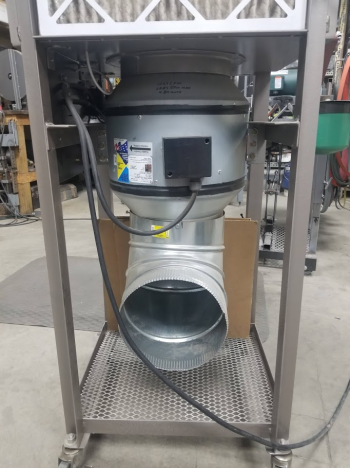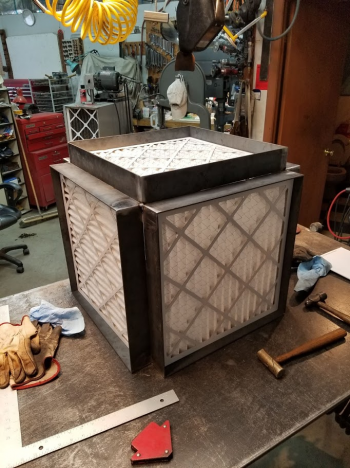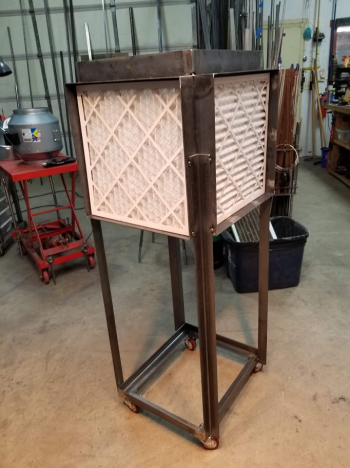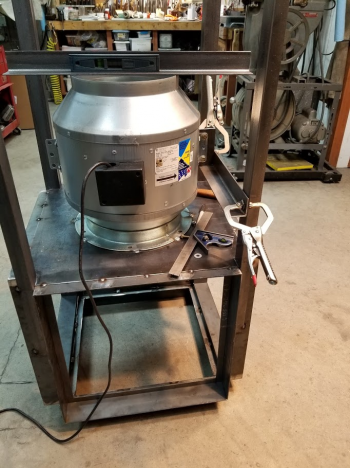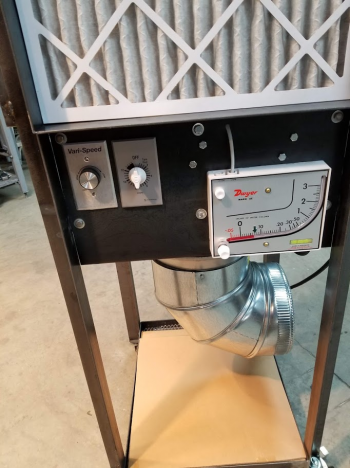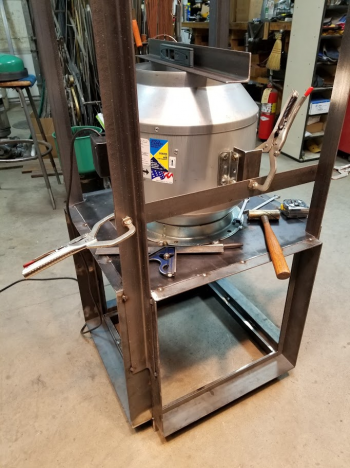MTBob
Well-Known Member
For a long time I've been frustrated with dust collection and general shop air filtration. I've used the common box Delta filter that often hangs from a ceiling with limited success. A fixed shop evacuation system with ducting doesn't work for me, much of my equipment is on wheels and too mobile to have adequate dust collection.
So, I designed a combination portable dust collector that also acts as a whole-shop air filter. Obviously, this isn't for everyone, but it's worked in my shop for over a year. Perhaps some of you will find the design concept something useful in making a filter for your shop.
Here's the unit set up for whole-shop general air filtration. It is a 6 sided box with 18"x18"x1" paper pleated Merv 8 and 13 filters in each face., except the dust collection face on the left. I chose the filter size to allow the assembly to easily fit through a door in my shop and based on needed filter surface area for particulate capture. It has a 1250 CFM commercial grade fan, exchanging the whole shop air volume in about 10 minutes. The pressure drop across the filters is monitored with a differential pressure gauge, and the fan run time is set on a 0-6hr timer. The DP gauge tells me when it's time to blow out or change the filters.
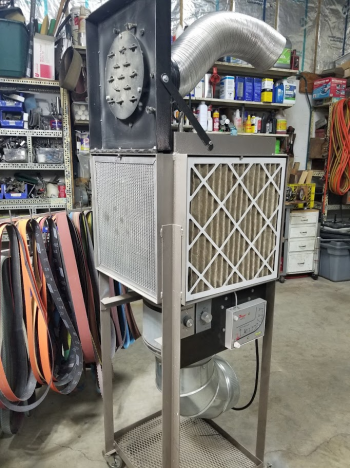
This view shows the dual filters in each face. In the general whole-shop air cleaning mode air borne particles are first captured in the vertical face & top filters and then, secondarily, in the two lower horizontal final filters just upstream of the fan inlet. The dust collection filter face uses a stainless steel washable filter that also serves as a spark arrestor. Behind it is a Merv 8 catch filter. The catch filter is the primary collection surface for point-source capture of grinding dust or fumes from welding. I clean that filter routinely with compressed air (outside).
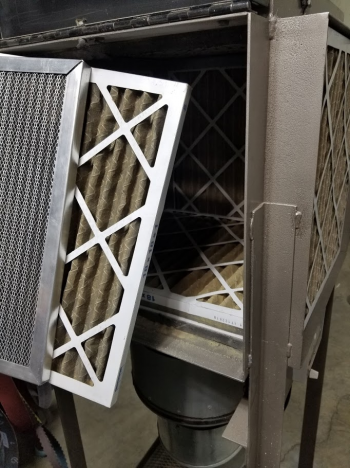
This is the point-source dust collection mode, in this case sitting behind the 2x72 grinder platen, capturing grinding material coming off the belt, not direct hot sparks from the belt. Note that in this mode cardboard pieces are placed in 4 filter faces (3 side & top) to increase air flow suction at the nozzle. This arrangement also works well to capture plasma torch and welding fumes.
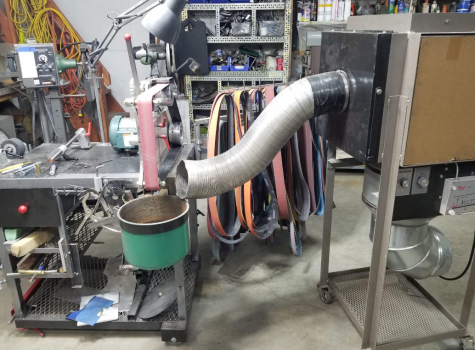
In the black section of the filter is where hot sparks are stopped from entering the filter - first the intake air hits a perforated baffle to deflect and slow air flow so there's is less direct air flow on the filter face. Each hole in the baffle holds neodymium magnets as a first catch for ferrous grindings. If hot sparks get past that point, the secondary catch point is the stainless filter. I periodically pull the magnets and clean them and blow material off the paper filter with compressed air. I use this point-source mode to catch metal grindings and handle grinding materials. Most important is capturing G-10 or other hazardous particles.
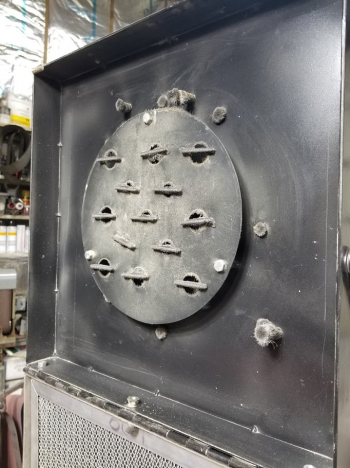
Initially I was concerned about hot sparks and fire issues with the paper pleated filters. That hasn't been a problem because the baffle, magnets and metal filter stop ferrous material before it gets to the pleated filter. I've tested the fire concern several times by having a full stream of hot sparks enter the nozzle. The magnets and metal filter stop anything from getting to the paper filter.
Typically I'll use the point-source dust catcher for various jobs during the day and then convert it to the whole-shop cleaning mode at night, letting it run for several hours after I've left the shop. This whole -shop air filter has significantly reduced fugitive dust throughout my shop.
WIP photos available.
So, I designed a combination portable dust collector that also acts as a whole-shop air filter. Obviously, this isn't for everyone, but it's worked in my shop for over a year. Perhaps some of you will find the design concept something useful in making a filter for your shop.
Here's the unit set up for whole-shop general air filtration. It is a 6 sided box with 18"x18"x1" paper pleated Merv 8 and 13 filters in each face., except the dust collection face on the left. I chose the filter size to allow the assembly to easily fit through a door in my shop and based on needed filter surface area for particulate capture. It has a 1250 CFM commercial grade fan, exchanging the whole shop air volume in about 10 minutes. The pressure drop across the filters is monitored with a differential pressure gauge, and the fan run time is set on a 0-6hr timer. The DP gauge tells me when it's time to blow out or change the filters.

This view shows the dual filters in each face. In the general whole-shop air cleaning mode air borne particles are first captured in the vertical face & top filters and then, secondarily, in the two lower horizontal final filters just upstream of the fan inlet. The dust collection filter face uses a stainless steel washable filter that also serves as a spark arrestor. Behind it is a Merv 8 catch filter. The catch filter is the primary collection surface for point-source capture of grinding dust or fumes from welding. I clean that filter routinely with compressed air (outside).

This is the point-source dust collection mode, in this case sitting behind the 2x72 grinder platen, capturing grinding material coming off the belt, not direct hot sparks from the belt. Note that in this mode cardboard pieces are placed in 4 filter faces (3 side & top) to increase air flow suction at the nozzle. This arrangement also works well to capture plasma torch and welding fumes.

In the black section of the filter is where hot sparks are stopped from entering the filter - first the intake air hits a perforated baffle to deflect and slow air flow so there's is less direct air flow on the filter face. Each hole in the baffle holds neodymium magnets as a first catch for ferrous grindings. If hot sparks get past that point, the secondary catch point is the stainless filter. I periodically pull the magnets and clean them and blow material off the paper filter with compressed air. I use this point-source mode to catch metal grindings and handle grinding materials. Most important is capturing G-10 or other hazardous particles.

Initially I was concerned about hot sparks and fire issues with the paper pleated filters. That hasn't been a problem because the baffle, magnets and metal filter stop ferrous material before it gets to the pleated filter. I've tested the fire concern several times by having a full stream of hot sparks enter the nozzle. The magnets and metal filter stop anything from getting to the paper filter.
Typically I'll use the point-source dust catcher for various jobs during the day and then convert it to the whole-shop cleaning mode at night, letting it run for several hours after I've left the shop. This whole -shop air filter has significantly reduced fugitive dust throughout my shop.
WIP photos available.


